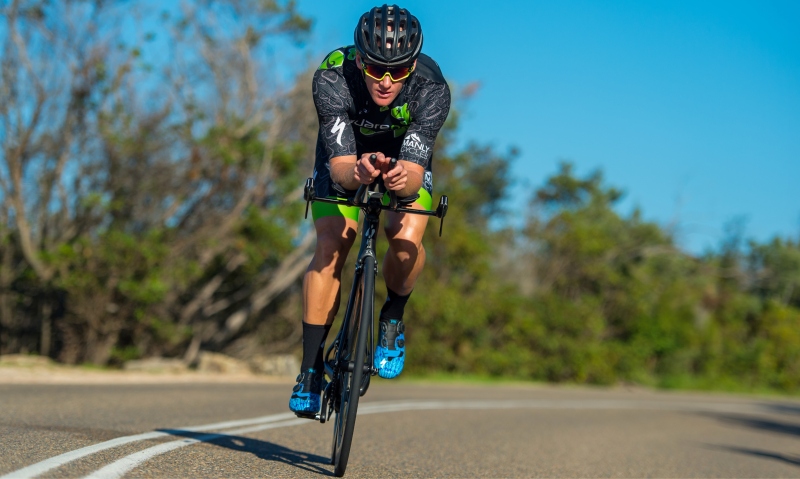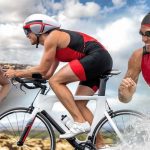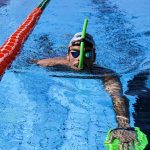Are you ready to push your body and mind to the limit? The Kona Ironman, held in beautiful Hawaii, is not just a race, but a true test of endurance. Only the most dedicated and determined athletes earn a spot on that starting line. Are you up for the challenge?
In this blog post, we’ll take a closer look at what it takes to qualify for the Kona Ironman and join the ranks of elite athletes who have conquered this grueling event.
The Kona Ironman consists of a 2.4-mile swim, 112-mile bike ride, and 26.2-mile run – all in one day. To qualify for this ultimate test of physical and mental strength, athletes must compete in other Ironman races throughout the year and earn enough points based on their finish times. However, with only a limited number of slots available at each qualifying event, competition is fierce.
But it’s not just about speed and endurance – athletes must also meet strict time cutoffs during each leg of the race to continue on. This requires not only physical strength but also mental toughness and determination.
For many aspiring athletes, qualifying for Kona is a dream that takes years of rigorous training to achieve. But even if you don’t make it on your first try, don’t give up. Many successful Ironman competitors have trained for years before earning their spot at Kona.
So are you ready to dive into the world of Ironman racing? Lace up your shoes and get ready for an unforgettable journey as we explore what it truly takes to qualify for the Kona Ironman.
Table of Contents
Volume Over the Long Term
The volume of training is a critical element in an athlete’s journey towards qualifying for the Kona Ironman over the long term. Working Triathlete, a highly respected coaching organization, has helped numerous athletes achieve their dream of participating in the Ironman World Championships in Kona through their effective training approach.
Here, we will explore how the training volume impacts an athlete’s ability to break the nine-hour barrier and qualify for Kona.
Consistency and injury prevention are two crucial components in developing deep, Ironman-specific fitness over time. This means that athletes must maintain a consistent training schedule while also taking necessary precautions to avoid injuries. The majority of high-intensity work should be focused on cycling as it is the longest discipline and poses a lower risk of injury compared to running.
In line with this, most of an athlete’s running training should be done at an easy pace, below their Ironman race pace. This helps build a strong aerobic base and prevents overtraining, which can hinder progress and lead to burnout. However, as the Ironman race approaches, volume and race-specific training become more crucial, with a heightened focus on developing efficiency at race intensity.
While training volume is essential, deliberate efficiency can enable athletes to achieve success with less training than traditional targets suggest. For instance, Conrad, an athlete who broke the nine-hour mark in his Ironman race, averaged only 10 hours and 24 minutes of swim-bike-run training per week in the 56 weeks leading up to his race. This showcases that with proper training and emphasis on efficiency, an athlete can reach their goal without needing excessively high training volume.
Other factors such as nutrition, body composition, sleep quality, and strength work also play a significant role in maximizing an athlete’s potential. It is crucial for athletes to have a holistic approach to their training, which includes proper nutrition and sufficient rest.
The Race-Specific Ironman Build
To build a race-specific Ironman, there are five key components that athletes must focus on: consistency, specificity, periodization, nutrition, and recovery. These elements work hand in hand to prepare an athlete for the unique and demanding challenges of the Kona Ironman and increase their chances of qualifying for the race.
Consistency is crucial when training for the Kona Ironman as it builds a strong foundation of endurance and mental fortitude. By gradually increasing the intensity and volume of workouts, athletes can sustain high levels of effort for an extended period of time.
Specificity is all about replicating the course’s terrain and conditions in training. This allows athletes to acclimatize to the environment and develop strategies to overcome obstacles during the race. It’s essential to train in similar conditions such as hills, wind, humidity, and heat to prepare for the challenges that lie ahead.
Periodization is a training approach that divides a training program into specific phases with different goals and focuses. This smart training method allows athletes to target different aspects of their fitness at different times. The base phase lays the foundation with longer, slower-paced workouts, while the build phase increases intensity and volume. The peak phase fine-tunes training and prepares athletes for race day.
Proper nutrition is crucial for fueling the body during training and on race day. Endurance athletes require a balanced diet with adequate carbohydrates, protein, and healthy fats to perform at their best. Recovery is also vital as it allows the body to repair and adapt to the stresses of training. Adequate sleep, stretching, foam rolling, and rest days are all essential for proper recovery.
By following a race-specific Ironman build plan, an athlete can improve their endurance, strength, speed, and mental focus specifically tailored for this challenging race.
Cycling Training
Cycling training is an essential aspect of preparing for the Kona Ironman race. To ensure success in this grueling event, there are numerous key elements that should be included in a cycling training plan.
These elements not only help athletes qualify for the Kona Ironman but also improve overall cycling performance and endurance.
- Establishing Goals: Setting a specific, measurable, achievable, realistic, and time-bound goal using the SMART acronym is crucial. This serves as motivation and guides the training plan.
- Race Planning: Along with the primary goal race, it is vital to include “B” and “C” races along the way to track progress and build confidence.
- Realistic Goal Time/Distance: Based on past performances, determining a realistic goal time or distance for the Kona Ironman and using it as a benchmark in training is paramount.
- Time Management: It is crucial to allow enough time to progress fitness before the goal race and consider availability to dedicate enough time for training (6-15 hours per week).
- Training Periodization: Creating an annual cycling training plan with macrocycles and mesocycles throughout the year to gradually build fitness and prevent burnout is vital.
- Variety in Workouts: Incorporating different types of rides in training, such as easy Zone 2 rides, long endurance-building rides, tempo rides/threshold intervals, and challenging faster-than-goal-race pace workouts like hill repeats, VO2 max intervals, and fartlek rides, is essential.
- Strength Training: To prevent injuries and enhance cycling performance, including core work, mobility exercises, and full-body strength training 2-3 times per week is recommended.
- Cross-Training: To prevent overuse injuries and muscle imbalances, adding 1-2 cross-training workouts per week such as swimming or running is beneficial.
- Rest Days: Resting is just as important as training. Be sure to include at least one rest day per week in the training plan to allow the body to recover and prevent burnout.
- Personalized Plan: Instead of relying on generic training plans found online, building a personalized plan that takes into account individual strengths, weaknesses, and goals is key.
By incorporating these key elements in a cycling training plan for qualifying for the Kona Ironman, athletes can significantly improve their chances of success in this challenging event. Remember to listen to your body, stay consistent, and stay motivated to achieve your goals.
Cycling training is a crucial aspect of preparing for the Kona Ironman race. To ensure success in this grueling event, there are numerous key elements that should be included in a cycling training plan. These elements not only help athletes qualify for the Kona Ironman but also improve overall cycling performance and endurance.
Goal setting is the first step in creating a successful training plan. It is essential to set specific, measurable, achievable, realistic, and time-bound goals using the SMART acronym.
Run Training
When it comes to the Kona Ironman race, running performance plays a critical role as it is the final leg of the competition. To excel in this aspect, it is crucial to have a structured training plan that targets your specific weaknesses while building upon your strengths. Here are some essential tips for improving your running performance for the Kona Ironman:
- Consistency is Key: Consistency in training is vital for developing deep, Ironman-specific fitness. This not only helps prevent injuries but also allows for steady progress towards your goals.
- Focus on Fundamentals: Building a strong foundation is crucial for success. Focus on fundamentals such as proper form, breathing techniques, and pacing strategies to become a more efficient runner and improve your overall performance.
- Tailor Training to Your Needs: Every athlete is unique, so it’s important to customize your training plan to fit your individual needs and abilities. Collaborate with motivated and disciplined athletes to stay accountable and push each other towards achieving your goals.
- Incorporate High-Intensity Workouts: While most high-intensity work is typically done on the bike for long-course racing, it’s still important to include some high-intensity workouts in your running training. Aim for one session per week to improve speed and endurance.
- Focus on Easy Runs: The majority of your runs should be easy, low-intensity efforts. This helps build your aerobic base and prevents burnout or injury from over-training.
- Don’t Neglect Nutrition and Body Composition: Proper nutrition and body composition are crucial for success in endurance racing. However, it’s important to approach these factors carefully to avoid disordered eating or negative impacts on performance.
- Efficiency Over Volume: While volume is important, being deliberate and efficient in your training can lead to success with less volume than typical Kona qualifiers.
- Increase Volume as Race Day Approaches: As race day approaches, it’s important to increase your volume and incorporate more race-specific training. This will help you prepare for the unique challenges of the Kona Ironman race.
- Don’t Forget About Swim Training: While running is the final leg of the Kona Ironman race, it’s crucial not to neglect swim training. For time-strapped athletes, scaling swim training may be necessary, but for a legitimate course like Kona’s, increasing swim volume may be necessary.
- Consider Other Factors: In addition to training, factors such as sleep, nutrition, and strength work also play a crucial role in long-course racing success. Make sure to prioritize these aspects of your training and give them the attention they deserve.
Swim Training
To qualify for the coveted Kona Ironman, having a strong swim performance is crucial. Below are some essential tips to enhance your swim training and boost your chances of qualifying for the race.
Hone your technique:
Efficient swimming starts with proper stroke technique. Focus on reducing drag by perfecting your body position and refining your arm, leg, and breathing techniques.
This not only increases your swimming speed but also conserves energy for the rest of the race.
Integrate strength training:
Swimming requires strength and endurance in key muscles like the back, shoulders, and core.
Incorporating strength-building exercises targeting these muscles will help you develop power and elevate your overall performance in the water.
Optimize nutrition:
Nutrition is vital for any athlete, including swimmers. Fuel your body with a well-balanced diet of protein, complex carbohydrates, and healthy fats to provide the necessary energy and nutrients for optimal performance.
Set achievable goals:
Having realistic goals is crucial for staying motivated and tracking progress. Set specific targets for your swim training, such as improving your time or increasing distance, to keep you focused and on track.
Create a personalized training plan:
Working with a coach or trainer to design a customized training plan is highly recommended.
A structured plan that includes various training methods like interval training, drills, and long-distance sets will effectively improve your swim performance.
Cross-train:
Incorporating other sports or exercises like yoga or weightlifting into your training routine can elevate overall fitness and prevent injuries. Cross-training also adds variety to swimming workouts, keeping them engaging and challenging.
Prioritize rest and recovery:
Giving your body time to rest and recover after intense training sessions is crucial for avoiding burnout and injuries.
Ensure you get enough sleep and schedule rest days into your training regimen.
Use visualization techniques:
Mental preparation is just as important as physical training. Visualizing perfect performance through mental rehearsal can boost confidence and motivation for race day.
Focus on mental toughness:
Endurance sports like triathlon require mental toughness. Incorporate mindfulness, meditation, or other techniques to help you stay focused and mentally strong during the race.
Monitor progress:
Tracking key metrics like time trials, stroke count, and heart rate can help identify areas for improvement.
This will enable you to adjust your training plan accordingly and make significant strides towards your goals.
By following these essential tips, you can elevate your swim performance and increase your chances of qualifying for the prestigious Kona Ironman race.
Other Factors
Aside from athletic prowess, there are other factors that can affect an individual’s chances of qualifying for the Kona Ironman, including previous race experience, age, nutrition and fueling strategy, mental fortitude, and financial resources.
These elements play a significant role in determining an individual’s overall performance and journey towards securing a spot in this highly prestigious race.
In the following sections, we will delve deeper into each of these factors and discuss how they can impact an individual’s chances of qualifying for the Kona Ironman.
| Factors | Description |
| Previous race experience | Participating in other long-distance triathlons and demonstrating the ability to overcome challenges can greatly improve an individual’s likelihood of qualifying for the Kona Ironman. |
| Age | Younger athletes may have an edge as there are typically more slots available in their age group. However, older athletes can still qualify with dedication and hard work. |
| Nutrition and fueling strategy | A well-planned nutrition and fueling strategy can significantly impact an individual’s performance and endurance during the race. |
| Mental toughness | The Kona Ironman is not just a test of physical ability but also mental strength. Individuals who possess mental toughness and resilience are more likely to succeed in qualifying. |
| Financial resources | The cost of participating in the Kona Ironman can be substantial. Therefore, having the financial means to cover expenses such as registration fees, travel, and gear costs can provide individuals with an advantage. |
In addition to these factors, there are other crucial elements that can impact an individual’s chances of qualifying for the Kona Ironman. These include training regimen, injury prevention, and proper rest and recovery.
A well-designed training plan tailored to an individual’s strengths and weaknesses can greatly improve their performance and increase their chances of qualifying. Additionally, taking steps to prevent injuries through proper form and technique is essential in maintaining peak physical condition.
Moreover, allowing the body adequate time to rest and recover is crucial in preventing burnout and sustaining long-term success in the sport.
Conclusion
In summary, qualifying for the Kona Ironman is a multi-faceted endeavor that requires more than just physical prowess.
It demands a combination of factors, including consistent training, race-specific preparation, and mental fortitude. Age, previous race experience, nutrition, and financial resources must also be taken into account on the journey towards securing a spot in this prestigious event.
A personalized training plan tailored to an individual’s unique needs and goals is essential for success, as well as adequate rest and recovery to prevent injuries and burnout.
With unwavering determination, unwavering dedication, and an unbreakable mindset, one can surpass the nine-hour barrier and join the ranks of elite athletes who have conquered this ultimate test of endurance.






